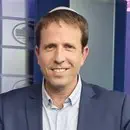Professor Chaim Sukenik, outgoing President of the Jerusalem College of Technology (JCT), spoke with Arutz Sheva-Israel National News at the recent annual Torah and Science Conference, sharing insights into the unique fusion of Torah values and scientific advancement celebrated at this long-standing event.
Professor Sukenik says, “It’s truly a pleasure to be here, especially in the context of this important event. Anyone familiar with the history of the Jerusalem College of Technology—originally Machon Lev—will know that the idea of combining high-level Torah study with high-level science and technology has been foundational for us from the beginning.
“After the Six-Day War,” adds Professor Sukenik, “Professor Ze’ev Lev, an Israel Prize-winning physicist and deeply respected Torah scholar, founded this institution with that very goal in mind, the combination of science and halacha. He authored many books on halacha, he was the advisor to many of the greatest decision-makers of his generation. The combination of high level Torah and high level technology is what has characterized our institution from its inception. This conference—now in its 31st year—grew out of a desire to bring together researchers and thinkers working at the intersection of Torah and science. Over the years, it’s come to be known as the "Conference of Torah and Mada (Torah and Science).”
Professor Sukenik is delighted that the JCT has, “partnered with several institutions over the years. Bar-Ilan University has been a longtime sponsor. We also work closely with institutions here in Jerusalem, like the Michlalah, as well as organizations such as MadaTorah, part of Rav Rimon’s initiative, which supports research at the interface of Halacha and modern science. We're proud to host this vital exchange of ideas.’
Despite the claim that Torah and science come from very different worlds—faith and tradition versus research and facts, Professor Sukenik is proud to say that, “Not only do they coexist—they enhance one another. A deeper understanding of science can enrich Torah learning, just as a strong foundation in Torah can offer new perspectives on scientific exploration. Today’s world presents challenges we couldn’t have imagined centuries ago, and often there's no direct precedent in Halachic literature for modern issues. That’s exactly why this synthesis is so necessary.”
“For instance, one of the most emotionally difficult yet intellectually important topics discussed this year involved the identification of victims from the October 7th attacks and the war that followed. Traditionally, identification in Halacha relied on visible, physical markers. But in many recent cases, that hasn't been possible. We're now forced to find new, reliable methods—scientific techniques that can withstand the scrutiny of Halachic decision-making in identifying bodies and knowing who has passed away. This morning’s session addressed exactly that, and it was both heartbreaking and inspiring to see top scientists and Halachic authorities working side by side,” he continued.
“One of the most meaningful outcomes of this work has been the mutual respect between scientists and rabbis that has developed. We now see scientists who genuinely appreciate the depth of Torah, and rabbis who deeply value scientific knowledge. It’s a shift that’s already influencing the next generation. At JCT, this is our mission: to cultivate an environment where students and faculty are fluent in both Torah and Mada, where excellence in both areas leads to stronger outcomes for the Jewish people and for society at large,” he concluded.
